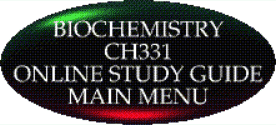

DR. JAKUBOWSKI
|
Icon List in OLSG |
||
|
|
Pre-Class Question | Post responses to questions before class without |
| Discus Question | Post responses to questions before class for all to see | |
| Chime Modeling | Ineractive molecular modeling displays of interesting molecules | |
| WebCT Quiz | Online Quizzes for your benefit which won't be graded | |
| XCel Spreadsheet | Spreadsheets which allow you to change variable and observe effects | |
| Java Applet | Interactive demonstrations to facilitate your learning of biological phenomena | |
| Check-In | Describe problems you have with the chapter material | |
| Online Literature | Full Text Online Articles from Leading Journals | |
Table of Contents
INTRODUCTION TO BIOCHEMISTRY Chapter 1: LIPID STRUCTUREChapter 7: CATALYSIS